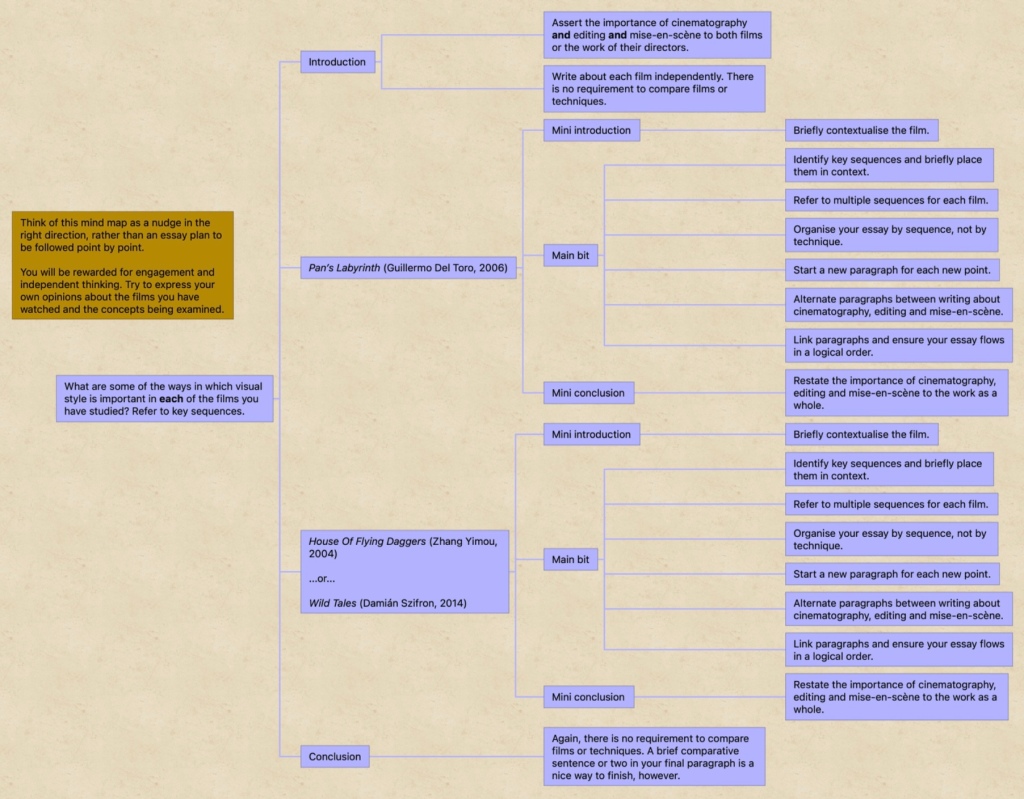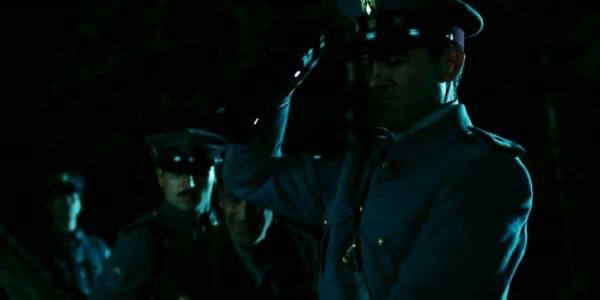“Discuss how aesthetics are used to communicate themes in your two chosen films. Make detailed reference to particular themes in your answer.”

Essay plan:
– Guillermo Del Toro uses many different unique methods of filmmaking to create a dark and fantastical aesthetic in pan’s labyrinth. – For this essay on aesthetics in pan’s labyrinth I will discuss the key elements of film form in certain key sequences from the film, and how these are combined to create an aesthetic. – Specifically the first shaving sequence and first bedtime sequence, and for these I will go into detail about how cinematography, sound, editing, mise-en-scen and performance are used to combine and create an aesthetic, and from there how this communicates themes. after these two sequences are done I will expand onto an overview on the whole film. – Here I will simplify how Del Toro uses film form to create aesthetic, using what I discussed in detail in the sequences as evidence for how the entire film is given an aesthetic, and from here how this is used to communicate themes. (The essay question is on pan’s labyrinth and wild tales but I am only discussing pan’s labyrinth)

Essay: Version 1.
In Pan’s Labyrinth, the film has a dark and mystical aesthetic that creates and emphasises themes of the supernatural, mystically, fantasy and violence. They are predominantly created via the films unique mise-en-scen and cinematography, but all fundamentals of film form are used by the director, Guillermo Del Toro, to communicate these themes.
For the first bedtime sequence, Del Toro mostly uses cinematography and editing to give the scene a fantasy aesthetic that evolves into a dark and intense tone. The scene begins in Ofelia’s mothers’ room. This is shown by a tracking shot of Ofelia that pan’s to the right to reveal the room. The room is made to look dark and gloomy via the silvery and blue-tinted colour pallet used in the film at night. This creates a dark and still environment, and also symbolises the Captain’s control on the setting, as his uniform is blue as-well. The scene is given a slow and calm pace to immerse the audience in the dialogue by keeping the camera on Ofelia and her mother and not cutting. The camera leaves this shot via a hidden cut when it pedestals down into the darkness in the sheets. When it reemerges it is showing the inside of Ofelia’s mothers womb. This makes the movement through the scene feel fluid and constant, creating a dream-like feeling and fantastical aesthetic. This communicates the themes of imagination, and the conflict between fiction and reality in the film.
The camera continues this smooth and gliding movement pattern as Ofelia tells a fairy-tale, as seen when it pans to the right, exiting Ofelia’s mothers’ womb and entering the mountain-top setting. This makes the audience feel like they are in a dream, symbolising Ofelia’s undying imagination and the fairy-tales that she believes in, helping us to understand how she imagines these stories. The hidden transition is also made more smooth by the red colour of the womb matching that of the sky in the mountain shot, making the audience not even realise a cut had been made, reinforcing the dream-like quality of the sequence, and also giving the environment a dark and sinister aesthetic with the deep colour of blood. The colour palette once again changes to a dark and silvery-blue as the camera pedestals down from the mountain top, making the transition back into the real world all the less noticeable, creating a dark and gloomy aesthetic that makes it hard to differentiate the story from the reality in the film, communicating the theme of Ofelia not knowing the difference between reality and fiction.
Mise-en-scen is also used to create aesthetic in the bedtime sequence. For example, Vidal’s uniform is pristine and organised , decorated and clean. This gives him a sinister and cruel aesthetic, showing the themes of his obsession with appearance, expanded on more in the first shaving sequence, and his dedication to patriotism for the fascist regime he serves under. The performance by him and his soldiers emphasises this, since his posture is upright and assertive, dominant, whilst his men closely follow him, staying behind him and completing his commands immediately. This shows his authority and ranking above everyone else. The theme of Vidal’s violence is also enforced further when his men look on in visible disgust at the murder of the farmers, emphasising the effect he has on people, and his lack of empathy. This gives Vidal a grim and cruel aesthetic as a character. When the doctor is talking to Vidal, Vidal is shown through low-angle shots which show the height contrast between him and the doctor, making the Captain seem like a much more imposing and intimidating figure. The gears and mechanisms shown in the backdrop of the basement give the scene an almost steampunk aesthetic, which emulates the cold heartless and robotic nature of Vidal, communicating the theme of cruelty and un-caring tyranny of Vidal.
When Vidal confronts the farmers, the camera stays on an over-the shoulder shot of them looking at him. This shows off their concerned expressions and postures, Vidal’s height compared to theirs, and also builds suspense as we see him searching their bags. This adds to Vidal’s powerful but evil and imposing aesthetic, showing the theme of his violence and indifference to innocence. The camera cuts between a close high-angle shot and a close low-angle shot as Vidal beats the farmer’s son to death. This rapid editing makes the scene more intense, amplifying the shock of Vidal’s violence. The camera angles place us in the position of Vidal to bring the audiences attention to the brutality, and the farmer’s son to show Vidal’s calm and collected expression as he commits this act. This distressing and memorable scene adds to Vidal’s aesthetic, making him a cruel and sadistic character as-well as a collected and cunning commander. This communicates the theme of Vidal’s two-sided character, who is both calm and authoritative, yet has the capacity to be extremely violent and is prone to outbursts of rage.
The first shaving sequence uses mise-en-scen and performance to create the aesthetic of Vidal’s character and portray the themes involving him and the relationship he has with other characters, such as the wealth divide. As Vidal looks into his mirror, we see how intent and concentrated he is, as-well as the way that he confidently strolls around his room and carefully prepares his shaving equipment. The lack of hair on his face, combined with the immense care with which he is going about such a simple task as of shaving, give the character a sinister and powerful aesthetic, which reflects the themes of Vidal’s pride and self-obsession
As Vidal sits in the dining room, mise-en-scen is used to represent his control over the wealth and rations of this part of Spain, and his attentiveness to his presentation. He sits, polishing his boots with full attention, reflecting his obsession with his appearance, and his tidy and decorated uniform represent his patriotism as a Captain, and also his careful attention to his presentation. When Vidal stands and places his hand on Mercedes’s shoulder, an over-the-shoulder shot shows how much taller he is than her, making him a more intimidating and imposing presence to the audience, giving him a threatening aesthetic and communicating the theme of his power over the environment and those in it. The kitchen is also designed to reflect his power, as seen in the completely stocked space for the fireplace, which is very large, and the very long dining table. These represent the Captain’s wealth and power over rationing, and also effects the pale-man’s dining room. His large coffee mug also contributes to the Captain’s powerful but corrupt aesthetic as a character which delivers the theme of the wealth divide between the peasantry and nobility/government in Spain during the Civil War. The theme of Vidal’s dominance and authority is also shown through low-angle shots that face up at him. This makes him seem like a much more giant and physically imposing figure than those like Ofelia or Mercedes, who are kept art eye-level.
In Pan’s Labyrinth, Guillermo Del Toro uses aesthetics to communicate certain themes, mostly via mise-en-scen and cinematography.. The first bedtime sequence is best for analysing how he can give a certain scene and environment an aesthetic, and the first shaving sequence shows how he can give characters aesthetic and can deliver themes through them and their surroundings. These aesthetics deliver certain themes such as wealth divides, the supernatural and the line between reality and fiction. This is done through cinematography that makes the audience see a character in a certain way, editing that creates a sense of fluid movement through a scene, and mise-en-scen that reflects themes and symbolises messages to the audience.
Band 4
There’s a lot of good stuff here, Finley. You describe the sequences accurately and do a good job of explaining the “so what?”
Your next step, and what would make this a Band 5 response, is to increase the frequency and accuracy of technical terminology. You need to more precisely identify and describe — in this case — the camera shots and movements that contribute to the unique aesthetic.
A good first go at this!
LikeLiked by 1 person
Thanks sir
LikeLike